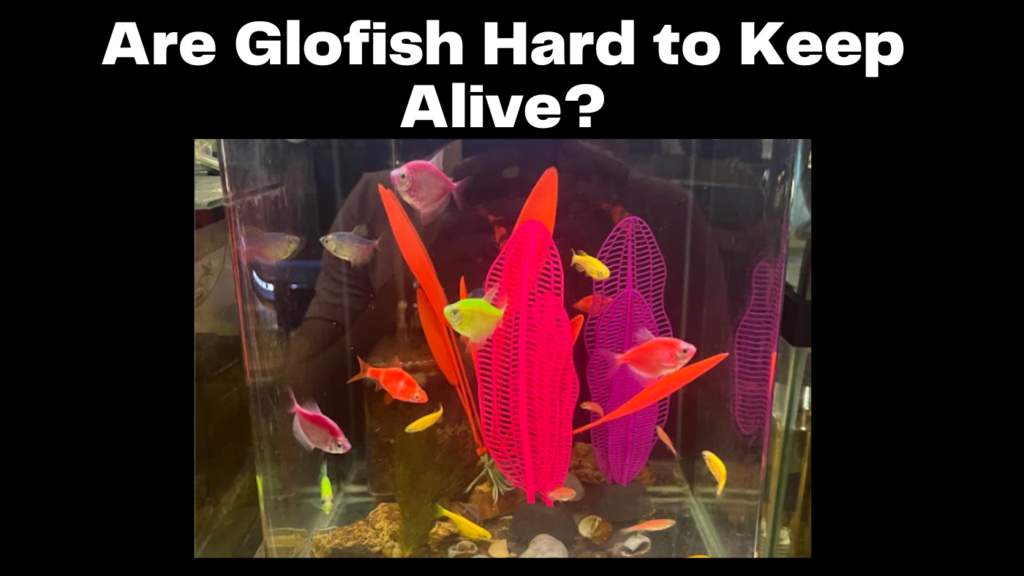For aquarium enthusiasts, the allure of vibrant and captivating Glofish is undeniable. However, it’s natural to wonder about the care requirements and whether these genetically modified fish are challenging to keep alive. In this article, we’ll explore the factors that contribute to the successful care and maintenance of Glofish.
Quick Overview of Glofish
Glofish are genetically modified variants of Zebrafish (Danio rerio) that exhibit striking fluorescent colors. These beautiful fish have been selectively bred to showcase hues of red, orange, green, and blue. While they possess a unique appearance, the care guidelines for Glofish are quite similar to those for their non-genetically modified counterparts.
Are Glofish Hard to Keep Alive?
Compared to other species of fish, Glofish are not hard to keep alive. The most important aspect of their care is to make sure they live in clean, healthy water.
Factors Affecting Success
Keeping Glofish healthy and thriving involves considering various factors. The first is water quality. Like most fish, Glofish require clean, well-maintained water to flourish. Regular monitoring of water parameters such as temperature, pH level, ammonia, and nitrite levels is crucial. Adequate filtration and regular water changes play a vital role in maintaining optimal water conditions.
Tank Setup and Environment
Creating a suitable tank environment is essential for the well-being of Glofish. A well-sized aquarium with appropriate space and swimming areas is recommended. The tank should be equipped with a reliable filtration system and a heater to maintain a stable and comfortable temperature.
Providing suitable hiding places, such as live plants or Glofish decorations, helps reduce stress and create a sense of security for the fish.
Nutrition and Feeding
Proper nutrition is key to keeping Glofish healthy. A balanced diet should consist of high-quality fish food specifically formulated for tropical fish. Additionally, supplementing their diet with occasional treats like freeze-dried or frozen foods can provide added variety and enrichment. It’s important to avoid overfeeding, as excess food can lead to poor water quality and health issues.
Tank Mates and Compatibility: What other fish can live with Glofish?
When selecting tank mates for your Glofish, it’s important to consider compatibility in terms of temperament and water parameter requirements. Choosing the right companions will help create a harmonious and peaceful community tank. Here are some compatible fish species that can coexist well with Glofish:
- Zebra Danios (Danio rerio): These non-aggressive and active fish make excellent tank mates for Glofish. Zebra Danios share similar water temperature and pH requirements, and their energetic nature complements the lively behavior of Glofish.
- Corydoras Catfish: Corydoras species, such as Corydoras paleatus (Peppered Corydoras) or Corydoras aeneus (Bronze Corydoras), are peaceful bottom-dwelling fish. They add a unique element to the aquarium with their playful antics and are compatible with Glofish.
- Harlequin Rasboras (Trigonostigma heteromorpha): Harlequin Rasboras are peaceful schooling fish that thrive in the same water conditions as Glofish. Their striking colors and graceful swimming patterns create a visually appealing display alongside Glofish.
- Cherry Barbs (Puntius titteya): These small and colorful fish are known for their peaceful nature. Cherry Barbs can coexist well with Glofish, and their vibrant red coloration adds an attractive contrast to the tank.
- Swordtails (Xiphophorus hellerii): Swordtails are peaceful fish that come in various colors and patterns. They are active swimmers and can cohabitate with Glofish, creating an interesting mix of colors and shapes in the aquarium.
- Neon Tetras (Paracheirodon innesi): Neon Tetras are another popular choice as tank mates for Glofish. These peaceful and visually striking fish form shoals and share similar water requirements, making them compatible companions.
- Algae eaters – I have a full article here where I discuss the top algae eaters to pair with your Glofish.
Remember to introduce tank mates gradually and monitor their interactions closely during the acclimation process. Some individual fish may have unique personalities, so it’s important to be observant and prepared to make adjustments if any signs of aggression or stress occur.
It’s worth noting that compatibility can vary based on the specific personalities of the fish involved. It’s always a good idea to research and consult with experienced aquarists or your local fish store to ensure the best possible compatibility between Glofish and their tank mates in your specific setup.
Common Challenges and Solutions
While Glofish are generally hardy fish, some challenges may arise. Diseases, such as ich or fin rot, can affect any fish species. Monitoring fish behavior, conducting regular health checks, and promptly addressing any signs of illness are important preventive measures. Consulting with knowledgeable aquatic professionals or experienced hobbyists can provide valuable guidance in addressing specific challenges.
Conclusion
Keeping Glofish alive and thriving is not inherently difficult. By providing optimal water conditions, a suitable tank setup, and a balanced diet, you can create an environment that promotes the health and well-being of these fascinating fish.
Understanding their specific care requirements, including appropriate tank mates and disease prevention, contributes to the long-term success of maintaining Glofish in your aquarium. With proper attention and care, Glofish can bring beauty and vibrancy to your aquatic world.
